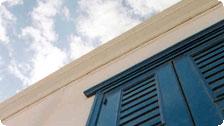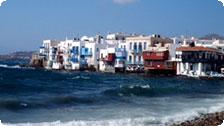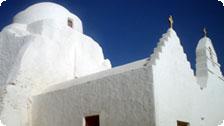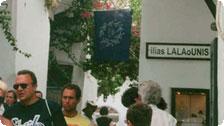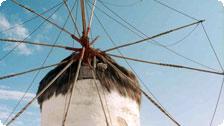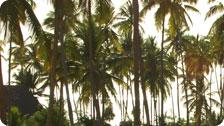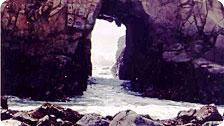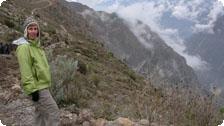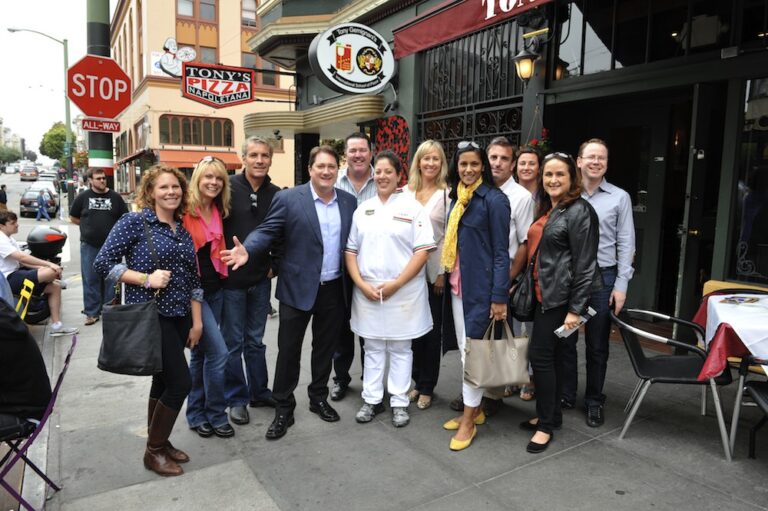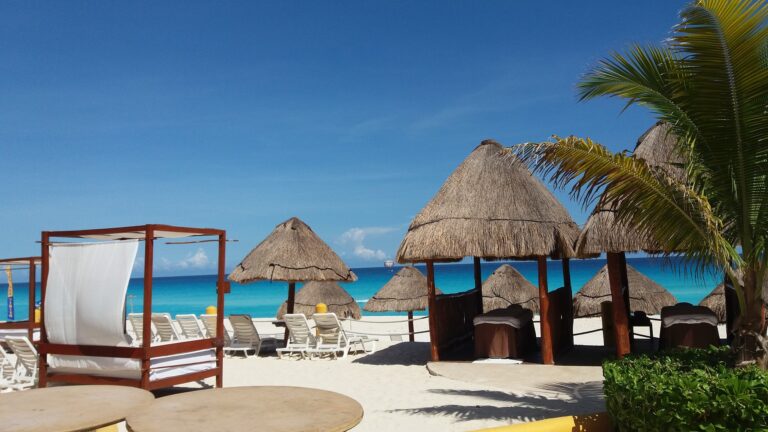Culture: Greece: The Blue Island
by Shauna Billings
Mykonos is called The White Island because of its whitewashed houses and churches that dust the low, rolling hilltops like powdered sugar. It could also be named The Blue Island, for to experience Mykonos is to finally see the color blue, in all its intricacies, for the very first time.
The doorways to the snow-white villas on the winding streets of the capital city, Chora, range from lively cornflower to gentle aquamarine hues, and the waves crashing wildly against the sea wall twinkle like a million dazzling sapphires in the bright sunlight. But it is not just the color that gave me a deeper understanding of blue; it was also the feeling of complete tranquility that immediately came over me as I stepped foot onto the Greek isle.
The city’s serene carefully-painted stone streets do not reflect the island’s tumultuous past. According to mythology, Mykonos was formed from the petrified bodies of the giants Hercules slew as his army attacked Mount Olympus. The island is a fifteen-minute boat ride from the sacred island of Delos, the birthplace of both Apollo, the god of light and truth, and of Artemis, the goddess of hunting.
Chora (often referred to as Hora or Mykonos Town) is a series of tight, maze-like roads that twist and turn like the meandros patterns on Greek key jewelry. The town’s roads were purposefully made disorienting to confuse pillaging pirates between the fifteenth and nineteenth centuries; today, they only serve to confuse tourists. The streets are lined with rows of galleries, tavernas, and shops, some of which stay open as late as two a.m., stocking everything from magnetic plaster replicas of Adonis statues to golden bracelets studded with emeralds and rubies.
Matoyianni, the main shopping street, winds past blue-picket gates that open onto private gardens, handsome jewelers who flirt with tourists on the steps of their shops, and cats that lie motionless in the cool shade on whitewashed stoops. Matoyianni ends on Gumenio Square, where the Pelican Restaurant beckons guests to escape the heavy rays of the Mediterranean sun beneath the fragrant awning of a flowering bougainvillea vine. A man in a black fisherman’s cap leans against the wall, a set of prayer beads in his hand, his eyes closed in contemplation, a carafe of wine before him. I sit at my table and watch him in happy silence as I drink water from a glistening blue bottle, sip frappi (iced coffee), and savor bites of baklava that flake into airy fragments and linger on my tongue in honeyed euphoria.
The Pelican is named after the island’s beloved mascot, Petros, who in 1954 was blown to the island by a storm. A fisherman found the injured bird and nursed him back to health, but Petros chose to remain on the island until he died. After his death, Jackie Kennedy Onassis, who owned a house on the island, donated a female pelican, Irini, to the island; the Hamburg Zoo sent Petros II.
At Niko’s Taverna, located in the center of Chora, the rich, smoky smell of roasted lamb rides on the wind. Every inch of sidewalk and every landing by Niko’s is crammed with tables covered in blue and white checked cloth, and every seat is filled with hungry locals and tourists eating souvlaki, spanakopita, and stuffed grape leaves.
The quiet peace of my evening meal is disturbed by a squat little guest who waddles down the path between the tables, chest puffed out, limbs tucked behind his back. Petros II is out for an evening stroll, stopping to spread his soft pink-tinged wings and pose for photographs with tourists. Niko beckons him, and Petros wiggles his three-foot frame over to the kitchen, where he is rewarded with fish and treats from the menu. He emerges with the yellow and blue gullet hanging from his long beak, rippling in satisfaction.
While Mykonos is known for its sunny, beautiful weather, the island also sees windy days that whip sand, loose menus, and lost hats across the island with an almost violent force. The waves crash wildly against the houses of Little Venice, an artist colony right along the water line. The waves fling salt and foam past the balconies (painted slate and robins egg blue) of houses that once served as quick loading and unloading sites for Greek merchants hoping to evade the greedy gaze of pirates.
To the left of Little Venice, past the rocky beach of Alfkandra, the windmills at Kato Myli sit high atop a hill that overlooks the wild sea and winding streets of Chora. The milk-white cylinders, with their peaked, thatched roofs, no longer refine grain; some sit crumbling in ruin, but the renovated ones house shops and families. The first windmill houses a tiny jewelry shop, Minotavros, a welcome respite from the brilliant sunlight and strong winds.
Back into the fading sunlight, the road winds back to town, towards Paraportiani, a blindingly white church set in the center of the Kastro, the oldest section of town. Paraportiani is made up of five smaller churches constructed between 1475 and 1650. Four churches form the base, with the fifth church built on top. As the moon begins to shine over the church’s cream-colored dome, the sky behind it fades from teal to salmon to the same darkening cobalt of the undulating sea below.
If ever there were a flag for aesthetes, it would be the Greek flag, with its stripes of blue and white, representing the sky, the ocean, and the houses. In Greece, you’ll find gold-sanded beaches, fuchsia flowering vines, and red-domed churches. But it is the blue—the bluest blue that ever was, the color of Greece—that is the most breathtaking.
* * * *
Shauna Billings grew up in Salem, Massachusetts. She spent much of her teenage years working at historical sites and gift shops, introducing her to people from all over the world and ultimately fueling her passion for travel. She now lives in New York City and heads out on adventures whenever she’s scraped together enough money for a plane ticket. Most recently, she’s traveled to Greece, France, Malta, Japan, and the Bahamas. She is already plotting her next journey, a road trip to California by way of Las Vegas. Baby needs a new pair of Manolos!
* * * *
When Visiting Mykonos
Places to Stay
Poseidan Hotel
Located in the heart of Chora, each room has a balcony or veranda with exceptional sunset views of the island.
Pelican Bay Hotel
This four-star hotel by Platos Gialos Beach is an ode to the natural surroundings of Mykonos in blues, whites and granite.
Rent a Studio or Apartment
Contact the Greece National Tourist Office (www.gnto.gr) to find reputable realtors and agencies.
Places to Swim
Agios Ioannis
A golden beach on the southwest coast of the island with a view of the island of Delos. Unlike many of the beaches, nude sunbathing is not permitted here.
Platos Gialos
Close to the center of Chora, this beach is easily accessed from town by a bus that runs late into the evening.
Paradise Beach
A nudist-friendly beach that attracts a young, party crowd with water sports, twenty-four-hour music and all-night beach parties. The beach can be reached by foot or boat from Plati Gialo.
Places to Dance
Paradise Club (Paradise Beach)
Booming house, techno, and rock music fills the air of this poolside club, which also puts on fireworks shows.
t 02.890.22.852
Spacedance Club (Chora)
This huge, two-level club is jam-packed with the Mykonos party crowd and rowdy tourists alike.
t 02.890.24.100
The Piano Bar and Montparnasse (Chora)
The Piano Bar is a cabaret with the singing in the streets, while directly above Montparnasse hosts a sunset cocktail hour boasting some of the most beautiful views of the island.
t 02.890.23.719
Places to Visit
The Island of Delos
Caïques (fishing boats) leave every hour from the port at Plato Gialos to this sacred island.
The Village of Ano Mera
Rent a scooter or take a bus to this town; don’t forget to visit the nearby monastery of Our Lady Tourliani, with its stunning bell towers and marble fountains.
The Mykonos Riding Center (Chora)
Go horseback riding through the sea, along the beaches, and on the trails to villages throughout the island with an English-speaking guide. Arrive early to avoid the hot afternoon sun, or wait until the evening for a spectacular sunset ride.
t 22.890.26.555
Places to Eat
Alefkandra (Chora)
A tavern next to the sea walls of Little Venice. Outdoor seating is competitive at sunset, due to the restaurant’s incomparable views. If you can score a table, don’t give it up until the sun goes down!
t 02.890.22.450
Niko’s Taverna
An indoor/outdoor restaurant with traditional Greek fare in the center of Chora.
t02.890.24.320
Discover more from Tango Diva
Subscribe to get the latest posts sent to your email.
